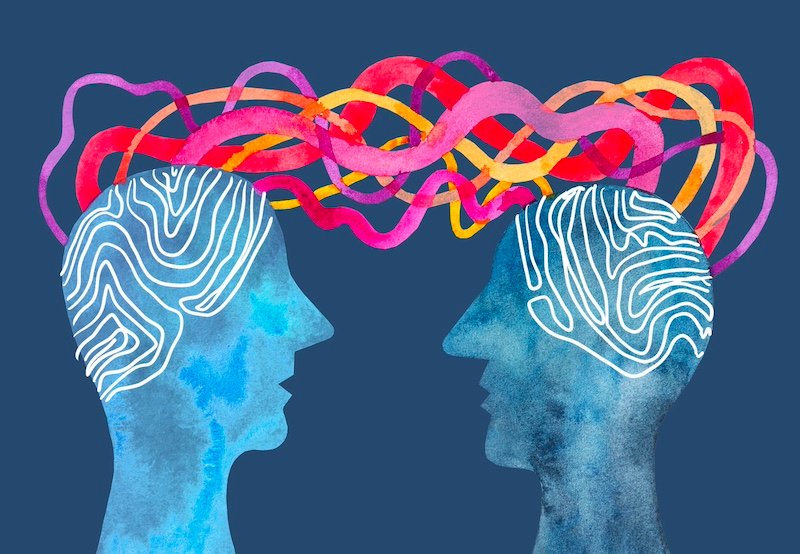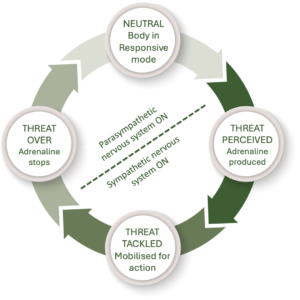
Part 2 of a 4-Part Series: Meet the Social Nervous System. Click here to read part 1.
Our social nervous system (or SoNS, pronounced “sons") is our relational survival system. It’s aim is to rapidly mobilise the group to act effectively together to tackle crises threatening the group’s survival. In the same way it only takes one zebra to spot a stalking lion for the whole herd to take fright and flee, so one individual’s detection of threat and danger moves contagiously across the whole group, driving collective survival behaviour.
Through an automatic and instinctive array of social signals, from subtle non-verbal facial micro-cues to dramatic changes in communication and behaviour, the social nervous system unleashes a collective sense of stress and dread. Each group member experiences the same physiological fight or flight adrenaline fuelled reaction to danger as if they had seen the threat firsthand for themselves.
While still highly effective in life or death scenarios, the array of complex, ongoing stressors in our 21st century life means that this ancient tribal survival pathway now sabotages our well-being more often than it secures it. To that end, long-term psychological health relies upon understanding, interrupting and regulating this social stress superhighway.
As individuals we have a highly effective solo reaction to threat which is known as our natural stress cycle. Removing our social relationships for a moment, when we personally detect danger, perhaps a car careering out of control towards us, adrenaline (which causes our symptoms of stress) surges through our body. Everyday internal processes like digestion are paused as energy is directed to our heart, lungs and muscles for action.
Almost instantaneously, our sympathetic nervous system, an array of nerves connecting brain and body, aligns all our internal bodily systems towards a single minded focus on survival and we adopt a restricted fight, flight or freeze repertoire of survival behaviours. Once threat is survived, adrenaline stops production, we gradually return to neutral once again and our experience of stress and tension subsides.

Our social stress cycle articulates the same cycle, but from the perspective of the group, it describes how adrenaline mobilises the team into a single minded focus on survival.
In the same way that the natural stress cycle utilises the sympathetic nervous system to focus the diverse systems of the brain and body, so it is our social nervous system (the term coined by D Kissell to describe this relational survival system) that focuses disparate individuals so that they think and act as one to maximise chances of survival.
The SoNS almost instantaneously passes the adrenaline fuelled tension from one individual to another, so that everyone feels tense, vigilant and mobilised for collective fight, flight or freeze action.

The Social Stress Cycle
Our solo and social survival pathways are entwined and integrated, such that activity in one stimulates action in the other. Sympathetic nervous system activity in one individual provokes SoNS social behaviours across the group and SoNS activity in others prompts adrenaline fuelled tension in ourselves. Working in conjunction with our brain’s threat appraisal process, these three systems create a collective adrenaline reaction that unlocks energy, focuses the mind and refines the senses for the proactive reactivity that is necessary for group survival.

Signals from our brain, body and social relationships are all entwined and integrated to offer a coherent response to stress
Our individual brain achieves the internal alignment of our bodily processes necessary for survival through nerve cell firing. Our social brain achieves the alignment of individuals through interrupting the balance of Individuality and Togetherness forces in our relationships.
When life is calm and settled we create a comfortable stability of Individuality and Togetherness forces in our relationships. We experience togetherness through a sense of belonging and acceptance, and our individuality needs are met through a recognition of our uniqueness and difference. Experiencing such balance allows us to thrive.
But at times of life or death threat, diversity and individuality become a hindrance. A multitude of ideas prevents the single-minded, decisive action necessary for survival. Thus the overarching purpose of the SoNS is to destabilise the comfortable Individuality/Togetherness balance and create fusion, the upper extremity of the Togetherness force, so that we merge together and fight, flee or freeze as if we were of one mind.


Threat disrupts our individuality / togetherness balance and prioritises fusion. the extremity of togetherness so we think, feel and act as one
The purpose of the SoNS is to instigate immediate group action for survival. The contagious stress is purposeful. Once effective fight, flight or freeze behaviour has removed the threat, the togetherness fusion force is no longer needed. Adrenaline drops, SoNS behaviours calm and affiliative relational dynamics that support group stability and quality connection can re-emerge.
The problem in today’s world is that the straightforward Threat to Body & Group mobilisation to Effective Action pathway is rarely so clear cut. The complexity of the challenges we face cannot be resolved quickly or decisively and so a state of chronic anxiety emerges.
Just as chronic anxiety is detrimental to our personal health, so it also significantly impacts our group health. The ongoing release of adrenaline intensifies and exacerbates our SoNS behaviours creating secondary relational stress. Secondary relational stress is the stress we experience because of people’s stressed out SoNS behaviours.
When Sally’s walks in through the front door after a rubbish day at work her internal stress regulation is exhausted. She starts to manage her stress through SoNS behaviours, and makes a tetchy comment at Mark. He catches the stress and expels it through an patronising remark back. Sally retaliates by withdrawing to the bedroom leaving Mark fuming and sending a moaning text to his brother. A ping ping game of conflict, overfunctioning, distancing and triangling (How Stress becomes Contagious unpacks the SoNS behaviours in detail) is spreading the stress around.
At the start there was a real problem to be solved, Sally had a rubbish day at work, and chatting it through or running a bath might have allowed Sally to self-regulate and calm down her inner adrenaline. But instead, the issue has been lost in the midst of time. Not even Sally remembers the root cause, and instead it is the secondary relational stress caused by their reactive SoNS behaviours which becomes the dominant cause of tension in the house.
When a group experiences long-term stressors or multiple pressures at the same time then the interaction patterns of the SoNS can become the default method of communicating. Without realising it, previously small issues like breaking a plate, suddenly become major events, mistakes are now unforgivable and seriousness replaces humour.
The normalisation of SoNS behaviour with a group breaks down the quality of trust, support and connection. Fusion rules and we never return to a place of balance where our individuality and our togetherness needs are acknowledged and met. Within the family, such intense fusion sees individuals scapegoated, communication cease and marriages end. Within the workplace teams disband due to unreconcilable issues, conflict, or unbearable micromanaging. Individuals start experiencing significant mental health problems due to the stress and anxiety constantly whirling around the group.
The social nervous system is powerful. It can help us survival and escape danger, but it can also be the danger.
Therefore for our well being and health we need to spot when the system goes live and interrupt the contagious passing of stress.
Thankfully this system is quite predictable.
Just like we can learn to recognise when our body is stressed by the predictable impact on our body: butterflies in our stomach, racing heart or shallow breathing, so we can group stress-led behaviours into patterned clusters which helps us spot and stop and contagion.
Read the next blog to learn about the clusters of stress-led behaviours